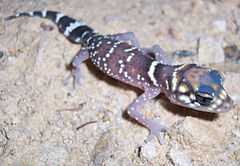Underwoodisaurus
| Underwoodisaurus | |
|---|---|
 | |
| Thick Tailed Gecko, Underwoodisaurus milii | |
| Scientific classification | |
| Kingdom: | Animalia |
| Phylum: | Chordata |
| Class: | Reptilia |
| Order: | Lacertilia |
| Family: | Carphodactylidae |
| Genus: | Underwoodisaurus |
| Species | |
|
2 recognized species, see article. | |
Underwoodisaurus is a small genus of Australian Gekkonidae, described as thick-tailed or barking geckoes.
The genus has a complex taxonomic history, but the currently accepted taxonomic concept follows Oliver & Bauer (2011),[1] with a second species subsequently recognised by Doughty & Oliver (2011).[2] Reptile systematists nowadays recognise a distinct family, Carphodactylidae, for this and some related genera.
Description
Adults of some species can reach a snout-to-vent length of 80mm. Preanal pores are absent. The feet are generally "bird-like" with long slender digits, and the tail is carrot-shaped. The underside of the body is white, and the dorsal surface ranges from dark purplish-black through reddish-brown to pale fawn, with small white, yellow and black spots in patterns.[3]
A thick tail is generally a sign of good health, although lack of thickness may indicate recent egg-laying.
Distribution
The genus Underwoodisaurus is endemic to Australia. These geckoes are found in a range of habitats including wet coastal heathlands, wet sclerophyll forests, arid scrubland, rocky outcrops and stony hills in eucalypt woodland.[3]
Ecology
Thick-tailed geckos shelter under leaf litter, around the bases of trees in loose bark, and in crevices.[3]
They emerge in the evenings to hunt in open areas[3] for crickets, cockroaches and huntsman spiders. They eat once every 3–4 days. When they see prey they will stare at it and wag their tails, then pounce. When alarmed, the thick-tailed gecko will make a barking sound or hiss. They will also raise their backs. One main predator is snakes.
Reproduction
Thick-tailed geckos lay up to 2 eggs and up to 10 clutches per year. The first clutch of eggs is usually infertile. When the female is gravid the eggs are visible through the skin. The eggs take about 65 days to hatch. Their breeding season is roughly July to February.
Species of genus Underwoodisaurus
- Underwoodisaurus milii (Bory de Saint-Vincent, 1825) Thick-tailed Barking Gecko
- Underwoodisaurus seorsus (Doughty & Oliver, 2011)[2] Pilbara Barking Gecko
- Underwoodisaurus sphyrurus (Ogilby, 1892)
References
- ↑ Oliver, Paul M.; Bauer, Aaron M. (June 2011). "Systematics and evolution of the Australian knob-tail geckos (Nephrurus, Carphodactylidae, Gekkota): Plesiomorphic grades and biome shifts through the Miocene". Molecular Phylogenetics and Evolution (Elsevier) 59 (3): 664–674. doi:10.1016/j.ympev.2011.03.018. Retrieved April 3, 2012.
- ↑ 2.0 2.1 Doughty, Paul; Oliver, Paul M. (31 August 2011), "A new species of Underwoodisaurus (Squamata: Gekkota: Carphodactylidae) from the Pilbara region of Western Australia", Zootaxa 30 (10): 20–30, retrieved April 3, 2012
- ↑ 3.0 3.1 3.2 3.3 Cogger, Harold G. (1994). Reptiles and Amphibians of Australia (5th ed.). Australia: Reed. pp. 275–276. ISBN 073010088X.
| Wikispecies has information related to: Underwoodisaurus |